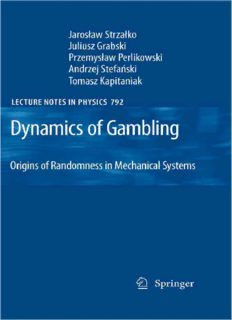Table Of ContentLecture Notes in Physics
FoundingEditors:W.Beiglbo¨ck,J.Ehlers,K.Hepp,H.Weidenmu¨ller
EditorialBoard
R.Beig,Vienna,Austria
W.Beiglbo¨ck,Heidelberg,Germany
W.Domcke,Garching,Germany
B.-G.Englert,Singapore
U.Frisch,Nice,France
F.Guinea,Madrid,Spain
P.Ha¨nggi,Augsburg,Germany
W.Hillebrandt,Garching,Germany
R.L.Jaffe,Cambridge,MA,USA
W.Janke,Leipzig,Germany
H.v.Lo¨hneysen,Karlsruhe,Germany
M.Mangano,Geneva,Switzerland
J.-M.Raimond,Paris,France
D.Sornette,Zurich,Switzerland
S.Theisen,Potsdam,Germany
D.Vollhardt,Augsburg,Germany
W.Weise,Garching,Germany
J.Zittartz,Ko¨ln,Germany
TheLectureNotesinPhysics
TheseriesLectureNotesinPhysics(LNP),foundedin1969,reportsnewdevelopments
in physics research and teaching – quickly and informally, but with a high quality and
theexplicitaimtosummarizeandcommunicatecurrentknowledgeinanaccessibleway.
Bookspublishedinthisseriesareconceivedasbridgingmaterialbetweenadvancedgrad-
uatetextbooksandtheforefrontofresearchandtoservethreepurposes:
• tobeacompactandmodernup-to-datesourceofreferenceonawell-definedtopic
• to serve as an accessible introduction to the field to postgraduate students and
nonspecialistresearchersfromrelatedareas
• tobeasourceofadvancedteachingmaterialforspecializedseminars,coursesand
schools
Both monographs and multi-author volumes will be considered for publication. Edited
volumes should, however, consist of a very limited number of contributions only. Pro-
ceedingswillnotbeconsideredforLNP.
VolumespublishedinLNParedisseminatedbothinprintandinelectronicformats,the
electronicarchivebeingavailableatspringerlink.com.Theseriescontentisindexed,ab-
stractedandreferencedbymanyabstractingandinformationservices,bibliographicnet-
works,subscriptionagencies,librarynetworks,andconsortia.
ProposalsshouldbesenttoamemberoftheEditorialBoard,ordirectlytothemanaging
editoratSpringer:
ChristianCaron
SpringerHeidelberg
PhysicsEditorialDepartmentI
Tiergartenstrasse17
69121Heidelberg/Germany
[email protected]
J. Strzałko
J. Grabski
P. Perlikowski
A. Stefan´ski
T. Kapitaniak
Dynamics of Gambling:
Origins of Randomness
in Mechanical Systems
ABC
JarosławStrzałko JuliuszGrabski
TechnicalUniversityofLodz TechnicalUniversityofLodz
DivisionofDynamics DivisionofDynamics
Stefanowskiego1/15 Stefanowskiego1/15
90-924Lodz 90-924Lodz
Poland Poland
[email protected] [email protected]
PrzemysławPerlikowski AndrzejStefan´ski
TechnicalUniversityofLodz TechnicalUniversityofLodz
DivisionofDynamics DivisionofDynamics
Stefanowskiego1/15 Stefanowskiego1/15
90-924Lodz 90-924Lodz
Poland Poland
[email protected] [email protected]
TomaszKapitaniak
TechnicalUniversityofLodz
DivisionofDynamics
Stefanowskiego1/15
90-924Lodz
Poland
[email protected]
StrzałkoJ.,etal.,DynamicsofGambling:OriginsofRandomnessinMechanical
Systems,Lect.NotesPhys.792(Springer,BerlinHeidelberg2009),
DOI10.1007/978-3-642-03960-7
LectureNotesinPhysicsISSN 0075-8450 e-ISSN 1616-6361
ISBN 978-3-642-03959-1 e-ISBN 978-3-642-03960-7
DOI10.1007/978-3-642-03960-7
SpringerHeidelbergDordrechtLondonNewYork
LibraryofCongressControlNumber:2009938265
(cid:2)c Springer-VerlagBerlinHeidelberg2009
Thisworkissubjecttocopyright.Allrightsarereserved,whetherthewholeorpartofthematerialis
concerned,specificallytherightsoftranslation,reprinting,reuseofillustrations,recitation,broadcasting,
reproductiononmicrofilmorinanyotherway,andstorageindatabanks.Duplicationofthispublication
orpartsthereofispermittedonlyundertheprovisionsoftheGermanCopyrightLawofSeptember9,
1965,initscurrentversion,andpermissionforusemustalwaysbeobtainedfromSpringer.Violationsare
liabletoprosecutionundertheGermanCopyrightLaw.
Theuseofgeneraldescriptivenames,registerednames,trademarks,etc.inthispublicationdoesnotimply,
evenintheabsenceofaspecificstatement,thatsuchnamesareexemptfromtherelevantprotectivelaws
andregulationsandthereforefreeforgeneraluse.
Coverdesign:IntegraSoftwareServicesPvt.Ltd.,Pondicherry
Printedonacid-freepaper
SpringerispartofSpringerScience+BusinessMedia(www.springer.com)
to
Jagoda,Aldona,Renata,Marzena,Gosia
–ourwives
Preface
Our everyday life is influenced by many unexpected (difficult to predict) events
usuallyreferredasachance.Probably,weallareasweareduetotheaccumulation
point of a multitude of chance events. Gambling games that have been known to
human beings nearly from the beginning of our civilization are based on chance
events. These chance events have created the dream that everybody can easily
becomerich.Thispursuitmadegamblingsopopular.
Thisbookisdevotedtothedynamicsofthemechanicalrandomizersandwetry
tosolvetheproblemwhymechanicaldevice(roulette)orarigidbody(acoinora
die)operatinginthewaydescribedbythelawsofclassicalmechanicscanbehave
insuchawayandproduceapseudorandomoutcome.
During mathematical lessons in primary school we are taught that the outcome
of the coin tossing experiment is random and that the probability that the tossed
coinlandsheads(tails)upisequalto1/2.Approximately,atthesametimeduring
physicslessonswearetoldthatthemotionoftherigidbody(coinisanexampleof
suchabody)isfullydeterministic.Typically,studentsarenotgiventheanswertothe
questionWhythisdualityintheinterpretationofthesimplemechanicalexperiment
ispossible?
Tryingtoanswerthisquestionwedescribethedynamicsofthegamblinggames
basedonthecointoss,thethrowofthedie,andtherouletterun.Thedynamicsof
thistypeofgamblingcanbedescribedintermsoftheNewtonianmechanics,soone
canexpectthattheoutcomecanbepredicted.Wegiveevidencethatfromthepoint
of view of dynamical systems this dynamics is predictable. However, due to high
(butfinite)sensitivitytoinitialconditionstheveryprecisedevicesarenecessaryto
predict the outcome, so practically this outcome is pseudorandom. Our studies do
notgivethegeneralanswertothefamousAlbertEinstein’squestionDoestheGod
play dice? which is connected with all the events in the whole universe but give
evidencetothenegativeanswertothesimplerquestionDoestheGodplaydicein
the casino? We give evidence that the pseudorandomness in mechanical systems
can be fully understood in terms of nonlinear dynamics as temporal sensitivity to
theinitialconditionsgeneratedbynonsmoothpropertiesoftherandomizers.
This book is mainly for mathematicians and physicists interested in nonlinear
phenomena. It can also be read by all interested in such chance problems as only
basic classical mechanics is necessary to understand most of the text. It is also
vii
viii Preface
addressed to gamblers but our results cannot be directly used to make fortune in
the casino. However our results can help to understand that the betting systems
that claim to be winning (particularly popular for roulette) are nothing more than
charlatanism.
The book is organized as follows. Typical mechanical randomizers like a coin,
a die, and a roulette are described in Chap. 2. In Chap. 3 we derive the equations
ofmotionwhichallowtodescribethedynamicsofthegamblingbasedonthecoin
toss, the throw of the die, and the roulette run. Chapter 4 explains why according
tothetheoryofthedynamicalsystemsthisgamblingispredictablebutpractically
unpredictable.Finally,inChap.5wediscusstheoriginofrandomnessinmechanical
systems.
We would like to acknowledge the helpful discussions with Eric Mosekilde,
Giusseppe Rega, Ko-Choong Woo, Marian Wiercigroch, and Serhiy Yanchuk. We
arethankfultoFranciszekWo´jcik,PiotrBorkowski,andPiotrDmuchowskiofthe
DepartmentofElectricalApparatus,TechnicalUniversityofŁo´dz´,forallowingus
tousetheirhighspeedcamera.
Ło´dz´ JarosławStrzałko
JuliuszGrabski
PrzemysławPerlikowski
AndrzejStefan´ski
TomaszKapitaniak
Contents
1 Introduction.................................................... 1
1.1 GamblingandGaming ....................................... 1
1.2 AShortHistory ............................................. 2
1.3 Coin....................................................... 6
1.4 Dice....................................................... 7
1.5 Roulette.................................................... 11
1.6 OtherMechanicalRandomizers................................ 14
1.7 DynamicsandPredictability................................... 17
1.7.1 SensitiveDependenceonInitialConditions ............... 18
1.7.2 FractalBasinBoundaries............................... 19
References ...................................................... 21
2 GeneralMotionofaRigidBody .................................. 23
2.1 BasicEquationsofMotionofaRigidBody...................... 23
2.1.1 DynamicsEquationsinGeneralForm .................... 23
2.1.2 Newton–EulerEquations .............................. 25
2.2 PrecessionofaBody ........................................ 26
2.2.1 PrecessionofSymmetricTop ........................... 27
2.2.2 Torque-FreeMotionofSphericalTop .................... 29
2.3 OrientationofaRigidBody .................................. 30
2.3.1 EulerAnglesandOtherConventions ..................... 31
2.3.2 Euler’sParameters .................................... 34
2.4 AirResistanceForcesandMoments ............................ 35
2.5 ModelingofBodiesImpact ................................... 37
References ...................................................... 39
3 EquationsoftheRandomizer’sDynamics .......................... 41
3.1 EquationsoftheCoinToss.................................... 41
3.1.1 FreeFallofaCoin .................................... 41
3.1.2 CoinMotionintheAir................................. 46
3.1.3 CoinBouncesontheFloor ............................. 64
ix
Description:This monograph presents a concise discussion of the dynamics of mechanical randomizers (coin tossing, die throw and roulette). The authors derive the equations of motion, also describing collisions and body contacts. It is shown and emphasized that, from the dynamical point of view, outcomes are pre

